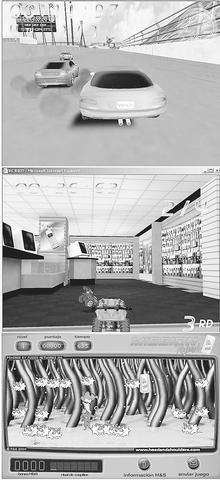Een on a modest computer, the revving of the virtual racing car's engine stirs anticipation. The car, low-slung and rendered for speed, glistens under a digitally created sky that is forever high noon.
It's the online computer game Dodge Speedway. With the click of a mouse, a player is behind the wheel and joining other racers jostling their way around a skid-scarred track to a throbbing soundtrack of techno music.

PHOTO: NY TIMES
The game, available at Microsoft's game site, MSN Gaming Zone (zone.msn.com/speedway), is free and entertaining.

PHOTO: NY TIMES
It is also an advertisement. The car, a replica of the real ones Dodge sponsors in real NASCAR races, is plastered with the automobile maker's name and logo. And every advertisement seen along the track's walls and billboards is for Dodge cars.
Dodge Speedway is one of a new genre of computer games as advertising vehicles.
Born of desperation and ingenuity, "advergames," as they are called by marketers, are emerging at a time when Web surfers largely ignore more conventional forms of advertising.
The games, ranging from simple, two-minute diversions to more sophisticated and addictive Web-based fare, help hawk everything from dandruff shampoo to big-budget movies. Some subject players to a kind of saturation bombing of brand names and product messages.
Others offer more subtle messages, akin to the product placement that is prevalent in movies these days.
Some games even permit advertisers to monitor players without their knowledge, tracking how long they play and what choices they make in the games. For instance, carmakers may want to know what makes, models and colors of cars players choose to race, ad-game developers said.
Already, games are available featuring products from major companies like Ford, Radio Shack, General Motors, Toyota, Proctor & Gamble and Sony Entertainment. Some games, like Dodge Raceway, are easily available on major gaming sites like Microsoft's Gaming Zone, mixed in, without any special notice, with conventional games.
Some advergames are also placed on the official sites of the products and services they are advertising. And consumers can expect to see more, lots more, experts say.
Many of the new games are viral, meaning that they permit players to spread the games by e-mail to friends. Some of the games are part of larger television advertising campaigns, urging television viewers to go online and online surfers to watch television. And there are tournaments and sweepstakes as additional inducements to play.
"Using games this way allows advertisers to do a number of things, like get a deeper commercial experience with the consumer," said Pat Keane, a senior analyst at Jupiter Media Metrix, an Internet research firm.
Consumers who play these games, Keane said, "are spending a number of moments with it, getting more than a fleeting message."
But these games are setting off alarms among some critics.
Beverly Goldberg, vice president of the Century Foundation, a New York research organization, and author of Overcoming High-Tech Anxiety: Thriving in a Wired World, said the games, while appearing harmless, may more easily slip under parents' radar and overexpose unsuspecting young people to commercial messages.
Goldberg said that the new games may also add to the general sense that advertising is ever more pervasive, creeping into movie theaters, automatic teller machines, waiting lines at fast-food restaurants, even jumbo television sets looming large over the public square.
"Advertising has changed dramatically in the last six months," said Goldberg, referring to the increased use of pop-up windows and now advertising games on the Internet. "The subliminal aspects of it are very frightening."
Redefining online advertising, including turning to games to sell products, was discussed earlier this month in New York during a forum on online advertising organized by Jupiter Media Metrix. Given America's US$7.4 billion-a-year fondness for computer games, it is not surprising that companies are looking to games to reach consumers, said Keith Ferrazzi, chief executive and president of YaYa, a Los Angeles developer of online advertising games and a participant in the forum, in an interview later. "What we have realized is that a game is media for brands," he said.
"The demographics that are core gamers today are the core demographics that influence broad consumer brands," Ferrazzi said.
"The youth are the biggest influencers of consumer brands. They're what defines what cool is, coupled with the middle-aged women who buy the stuff."
Game sites represent eight of the top 10 entertainment sites on the Internet, according to Nielsen/Net Ratings, with 40 million households expected to play games of all kinds online by 2004, according to IDC, an Internet and technology research firm.
So far, companies using advertising games say they have been well received by consumers, citing online surveys. More important, the companies say, the games have been effective.
A player of Procter & Gamble's Mission Refresh, an online game in which players help Captain Cool eradicate dandruff creatures with bubbles and bottles of Head & Shoulders shampoo, sent an e-mail note to the company that said of the game, "Gotta send it by e-mail to the whole world."
When Toyota's Adrenaline racing game appeared on Microsoft's MSN Gaming Zone site last year, research found that the typical player returned to the game three to four times a month. That player also spent about 20 minutes with it each time -- far longer than consumers might spend with a typical advertisement on the Internet.
A survey of MSN Gaming Zone users before the Adrenaline game went online found that Toyota's brand awareness ranked No. 6 among major car companies. Three months later, after the game went online, a survey found that Toyota's brand awareness had risen to No. 2, said Jon Fascitelli, director of media, entertainment and advertising for Wild Tangent, in Redmond, Washington.
Wild Tangent developed the Toyota and Dodge games, as well as a similar racing game for Radio Shack. In the Radio Shack game, players select one of dozens of remote-controlled cars, each a dead ringer for one sold in the company's stores, and drive it around a virtual, three-dimensional Radio Shack outlet, getting an eyeful of other merchandise along the way.
"It's all about the game play," said David Madden, executive vice president of sales and development for Wild Tangent. Madden added that games are natural marketing tools because they are deeply immersive and create a sense of event around a brand.
"If it is an intrusive and blatant advertisement with no entertainment value for the consumer, it is going to do two things," said John Mass, a senior vice president of the William Morris Agency, who oversees the company's representation of corporate clients involved in the entertainment, leisure-time and new-media industries. "It is going to completely turn consumers off from playing the games and possibly affect how they feel about the product."
As the Internet has grown increasingly mainstream in recent years, broadening its appeal, companies have steadily sought better ways to use it to market products and services. They have had only limited success.
The banner advertisement, a sort of interactive billboard that beckons Internet users to click for more information, have become commonplace. But recent studies note that few people, less than 1 percent of Internet traffic, pay significant attention to banner advertisements. And worst, alternatives like pop-up and pop-under ads -- windows that open on top or beneath Web pages -- have proved to annoy and infuriate many Web users.
"The Internet has not proved to be an effective branding tool," said Keane at Jupiter Media Metrix.
That, he said, could change if online games as advertising connect with only a segment of the millions of people who use the Internet every day.
Typically, the games -- all are designed to work very well on dial-up Internet connections -- are easy to learn and play. Games created by YaYa, for example, require only common, Java-enabled Web browsers.
Most of the games are controlled by a computer keyboard's directional buttons, and the object is to drive a vehicle around or through a track, avoiding obstacles and picking items that increase the power of the vehicle in some way.
In a racing game for Burger King, for instance, players have to drive a character from Rugrats, the popular Nickelodeon cartoon series, around the track without being captured by Reptar, a toy reptile seen in the series.
Many of YaYa's games, which tend to be two-dimensional and cartoonish, take a soft-sell approach, usually showing only a product logo somewhere in the game. YaYa's lunar lander game for Ford Motor Canada asks players to set a spacecraft on various landing pads by controlling its flight and rate of descent.
The keyboard's direction buttons fire thrusters, complete with roar and animated flames. Only the Ford logo (and lots of Canadian flags on the lunar surface) is seen on the craft (there is also a Ford logo in a corner of the game screen).
One of the newest advertisement games that YaYa has put on the Internet is intended to help General Motors' customers better understand a new high-tech control system called eMotion.
The system affects the engines and transmissions in some of the latest vehicles GM is marketing.
The GM eMotion Challenge game lets consumers learn about the system while driving virtual cars that use it.
The better you drive the cars, the better your chances become of trying out the system on more expensive cars, eventually working your way up from a Cavalier to a Corvette.
"The eMotion control system is a very technical system and it is very hard to get people to learn about it and understand it," said Bill Lussier, brand manager for eMotion. "Turning it into sort of a game could help demonstrate the features of the system."
Ferrazzi of YaYa agreed, noting that advertising games work mostly because they are an easy sell to an audience that is increasingly drawn to digital entertainment -- especially if it is engaging and free.
No one seems to mind the advertising messages, he said.
"Hey," he added with a chuckle, "this is not rocket science."

US PUBLICATION: The results indicated a change in attitude after a 2023 survey showed 55 percent supported full-scale war to achieve unification, the report said More than half of Chinese were against the use of force to unify with Taiwan under any circumstances, a survey conducted by the Atlanta, Georgia-based Carter Center and Emory University found. The survey results, which were released on Wednesday in a report titled “Sovereignty, Security, & US-China Relations: Chinese Public Opinion,” showed that 55.1 percent of respondents agreed or somewhat agreed that “the Taiwan problem should not be resolved using force under any circumstances,” while 24.5 percent “strongly” or “somewhat” disagreed with the statement. The results indicated a change in attitude after a survey published in “Assessing Public Support for (Non)Peaceful Unification

The CIA has a message for Chinese government officials worried about their place in Chinese President Xi Jinping’s (習近平) government: Come work with us. The agency released two Mandarin-language videos on social media on Thursday inviting disgruntled officials to contact the CIA. The recruitment videos posted on YouTube and X racked up more than 5 million views combined in their first day. The outreach comes as CIA Director John Ratcliffe has vowed to boost the agency’s use of intelligence from human sources and its focus on China, which has recently targeted US officials with its own espionage operations. The videos are “aimed at

STEADFAST FRIEND: The bills encourage increased Taiwan-US engagement and address China’s distortion of UN Resolution 2758 to isolate Taiwan internationally The Presidential Office yesterday thanked the US House of Representatives for unanimously passing two Taiwan-related bills highlighting its solid support for Taiwan’s democracy and global participation, and for deepening bilateral relations. One of the bills, the Taiwan Assurance Implementation Act, requires the US Department of State to periodically review its guidelines for engagement with Taiwan, and report to the US Congress on the guidelines and plans to lift self-imposed limitations on US-Taiwan engagement. The other bill is the Taiwan International Solidarity Act, which clarifies that UN Resolution 2758 does not address the issue of the representation of Taiwan or its people in

SHIFT: Taiwan’s better-than-expected first-quarter GDP and signs of weakness in the US have driven global capital back to emerging markets, the central bank head said The central bank yesterday blamed market speculation for the steep rise in the local currency, and urged exporters and financial institutions to stay calm and stop panic sell-offs to avoid hurting their own profitability. The nation’s top monetary policymaker said that it would step in, if necessary, to maintain order and stability in the foreign exchange market. The remarks came as the NT dollar yesterday closed up NT$0.919 to NT$30.145 against the US dollar in Taipei trading, after rising as high as NT$29.59 in intraday trading. The local currency has surged 5.85 percent against the greenback over the past two sessions, central